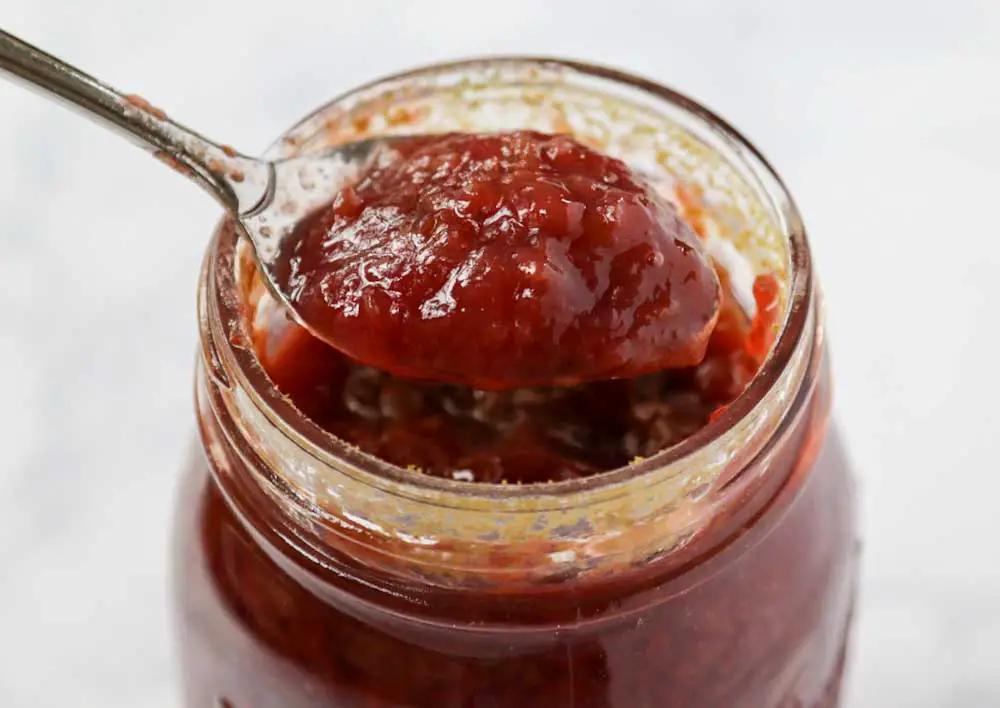
One of our favorite things to do as a family is go to pick-your-own farms. It’s a great way to not only stock your freezer and pantry for the next several months, but also to learn what grows well near you.
Not long after we moved to our current location, we discovered that there was a muscadine grape patch 5 minutes from our house that hosted a few pick-your-own days every summer. The little vineyard belongs to the horticultural department at our nearby university, and they invite the community to come pick fresh muscadine grapes every year when they ripen.
A few hot, sweaty hours after arriving, we headed home with a trunk full of about 15 pounds of sweet, jewel-like muscadine grapes. I washed them, froze them, and – as is usually the norm when I have an abundance of fresh fruit – used a good amount to make homemade jam.
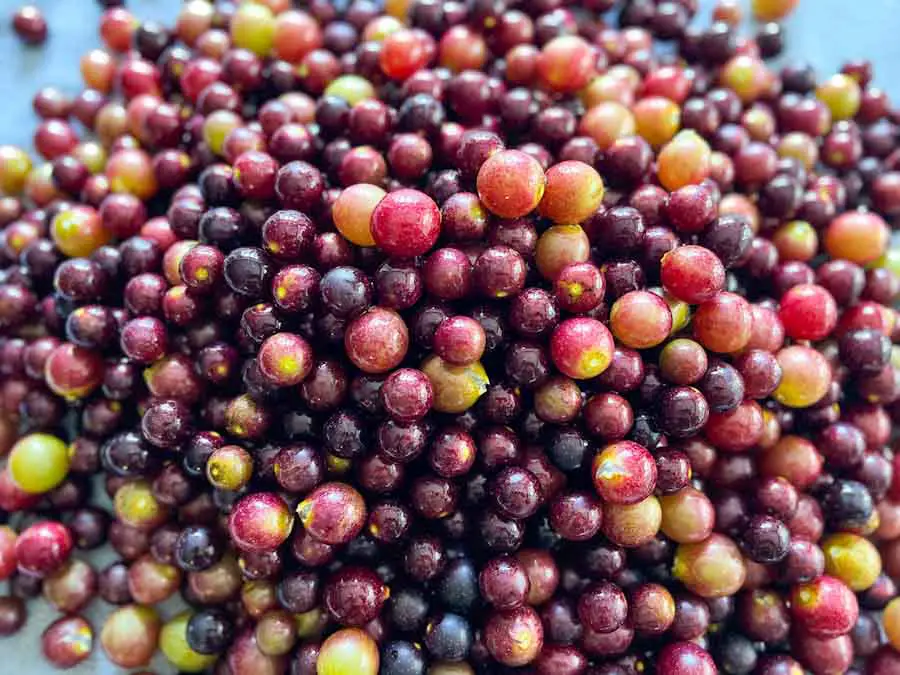
Muscadine jam has a few extra steps than other fruit preserves, but I promise it’s worth it. The grape skins are very thick and rather fibrous, so they need to be removed and finely chopped before cooking. Muscadines also have seeds, so unless you like crunchy jam, those have to go too.
But the extra labor is worth it in the end. This jam reminds me almost of a plum jam – rich and sweet and complex (because of the flavor in the skins), and not as “grape-y” as concord grape jam.
Whenever I’m making fresh fruit jam – whether it’s from my own backyard, a pick-your-own farm, or just a really lucky haul from the grocery store – my goal is to make it taste as much like the actual fruit as possible. This means using as little sugar as I can get away with.
Most jam recipes use tons of sugar – I’m talking, 3 or 4 times what I’ve used in this recipe. If you are making jam without pectin, you need the extra sugar to help it to thicken and jell. But by using no-sugar (or low-sugar) pectin, the flavor of the fresh fruit stays in the jam.
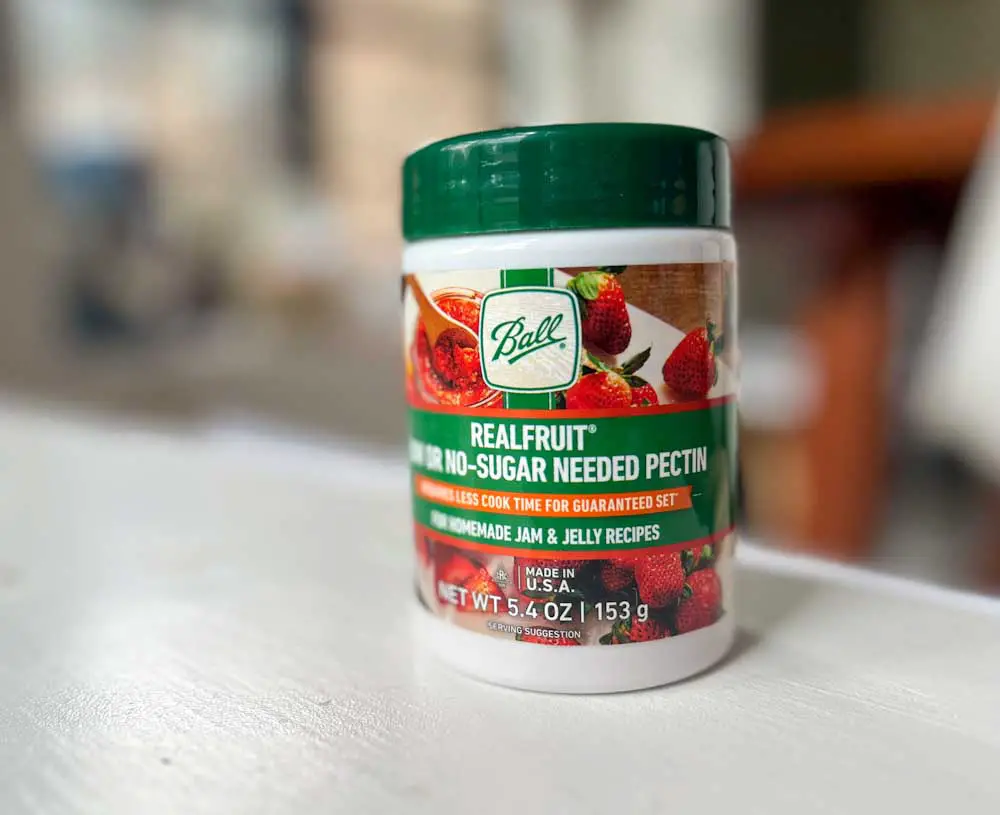
Pectin is a naturally-occuring fruit starch that can acts as a thickener and stabilizer for jams and jellies. It typically needs some sugar and acidity to set properly. Some fruits, such as apples and citrus, naturally contain high amounts of pectin. Other fruits benefit from added pectin in order to thicken into jam (without having to cook it to death).
For this jam, start by removing the skins from the grapes. I know this sounds like a lot of work, but it’s not really that difficult (and is actually kind of satisfying). I used grapes that I had previously frozen from our picking haul, then defrosted. This worked really well since they softened up after defrosting, making it easy to remove the skins.
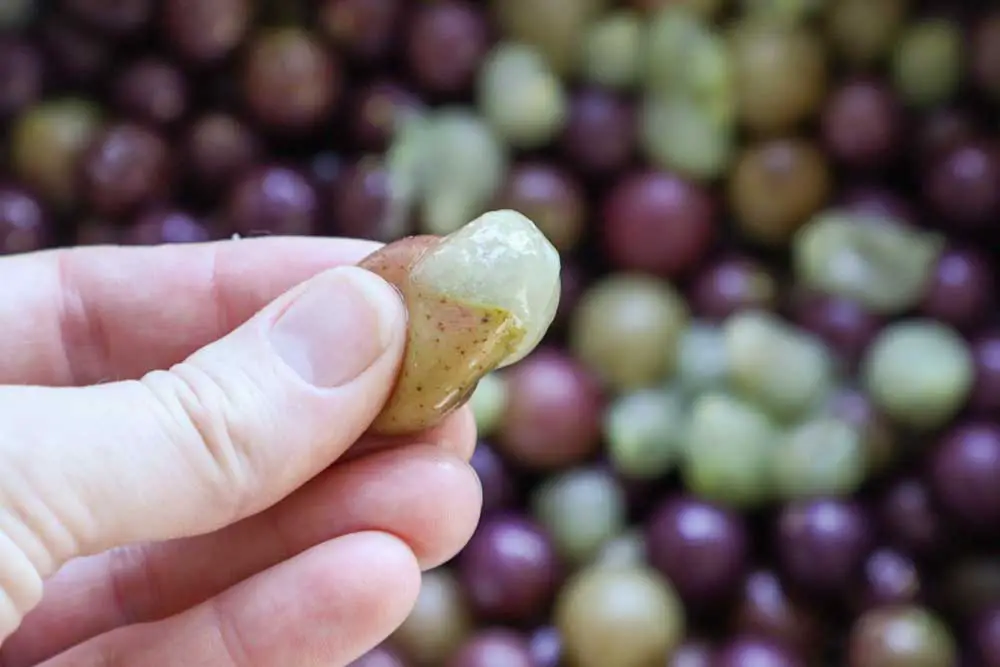
Most of the skins broke in the defrosting process, so it was a simple matter of pinching one end of the grape to squeeze out the pulp. For fresh muscadines, use a paring knife to cut a small X in one end, then squeeze the pulp out by pinching the opposite end. (Pro tip – my kids loved helping to squeeze the pulp out of the grapes!)
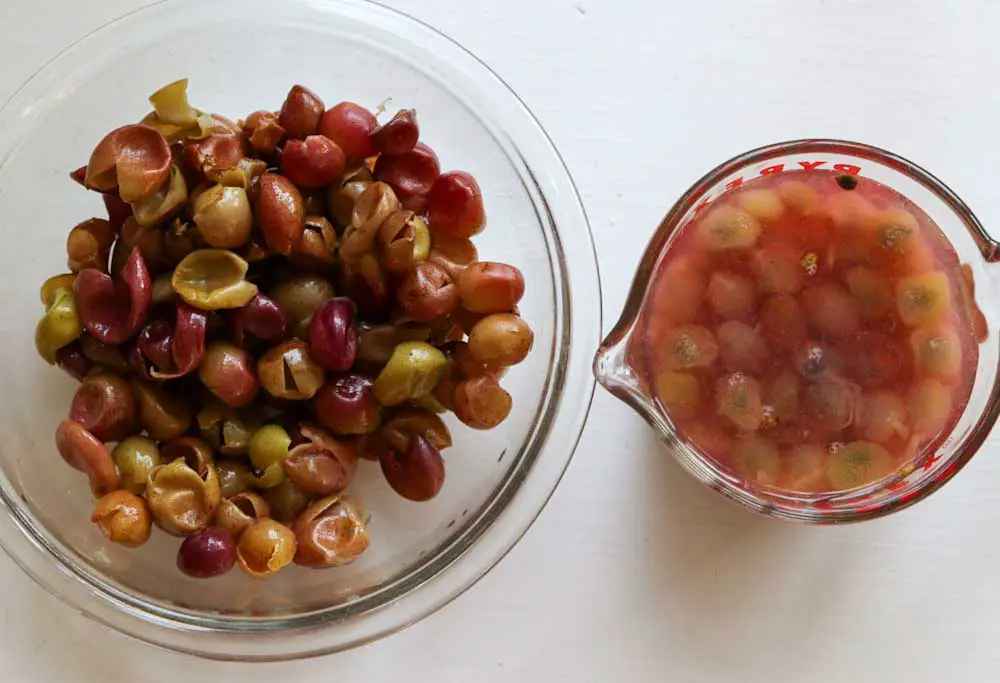
Once the skins and pulp are separated, cook the pulp for a few minutes to soften it. Then pulse the goo in a food processor and strain out the seeds (or work the mixture through a food mill to remove the seeds).
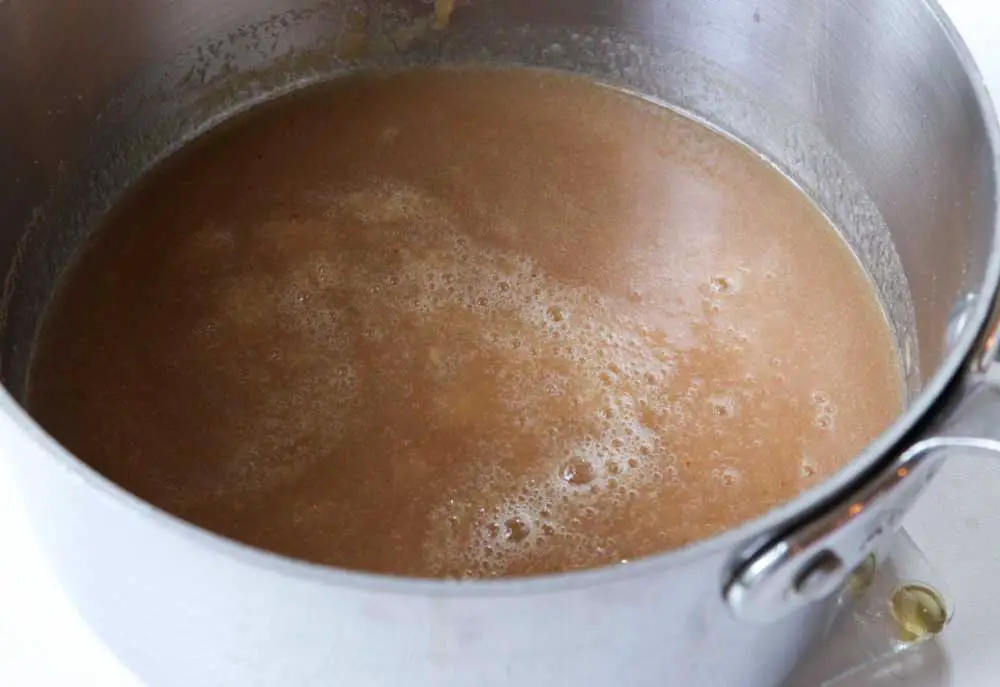
The thick skins need to be finely chopped up so the final texture of the jam isn’t unpleasantly chunky. I found the simplest way to do this was in the food processor – just pulse until the skins are chopped into tiny pieces.
Then, cook the seedless pulp and chopped skins together for about 10 minutes until the skins are really soft. You can continue on with the pectin and sugar at this point if you like some texture in your jam. Otherwise, puree the fruit mixture smooth with an immersion blender or regular blender.
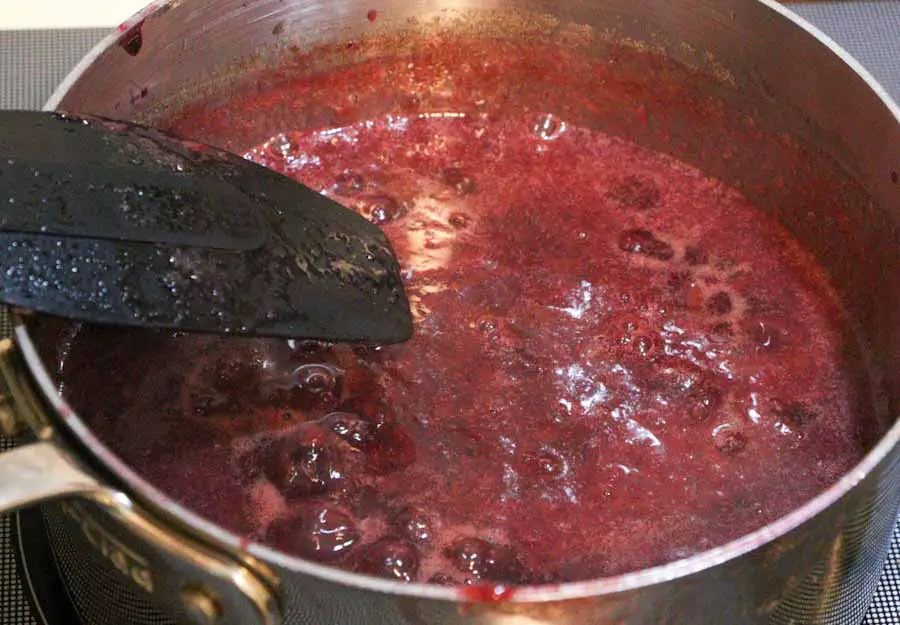
Mix together the pectin with about ¼ cup of the sugar in a small bowl. The sugar helps keep the pectin from clumping together when you add it to the fruit Bring the smooth (or textured) fruit mixture to a boil, and add the pectin-sugar mixture. Boil for 1 minute.
Next, add in the remaining sugar and boil for an additional minute to make sure the sugar is completely dissolved.
At this point, check to make sure the jam has jelled correctly. I like to put a couple of spoons in the freezer for this purpose. Take one of the chilled spoons and scoop up a little jam. It should start jelling right away – you can tell it’s ready if the jam on the spoon is viscous and has little wrinkly edges. Give it a taste to check for sweetness, too.
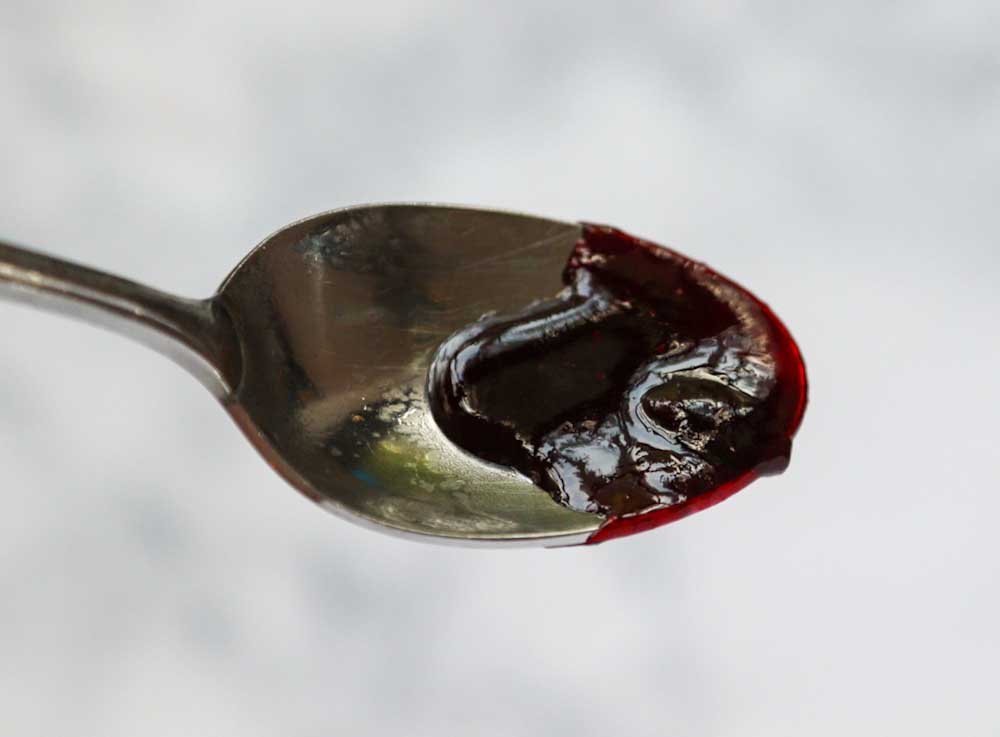
If the jam hasn’t jelled, add a tablespoon of additional pectin and boil for 1 minute. Check for jell again, and repeat until the jam has set properly. Every batch of fruit is different, so the amount of pectin may differ from batch to batch.
You can also adjust the sweetness at this point. If you prefer your jam sweeter, add sugar about ¼ cup at a time until it tastes the way you want it. Be sure to boil the mixture for a minute after adding additional sugar. Just like with pectin, the sweetness of the muscadines can vary, so the amount of sugar needed may change. It’s best to start with the least amount, then add as necessary.
Once you are satisfied with the texture, the jam is done! Ladle the mixture into jars and keep them in the fridge for up to 2 weeks. Or, freeze the jam in freezer-safe containers for up to 3 months.
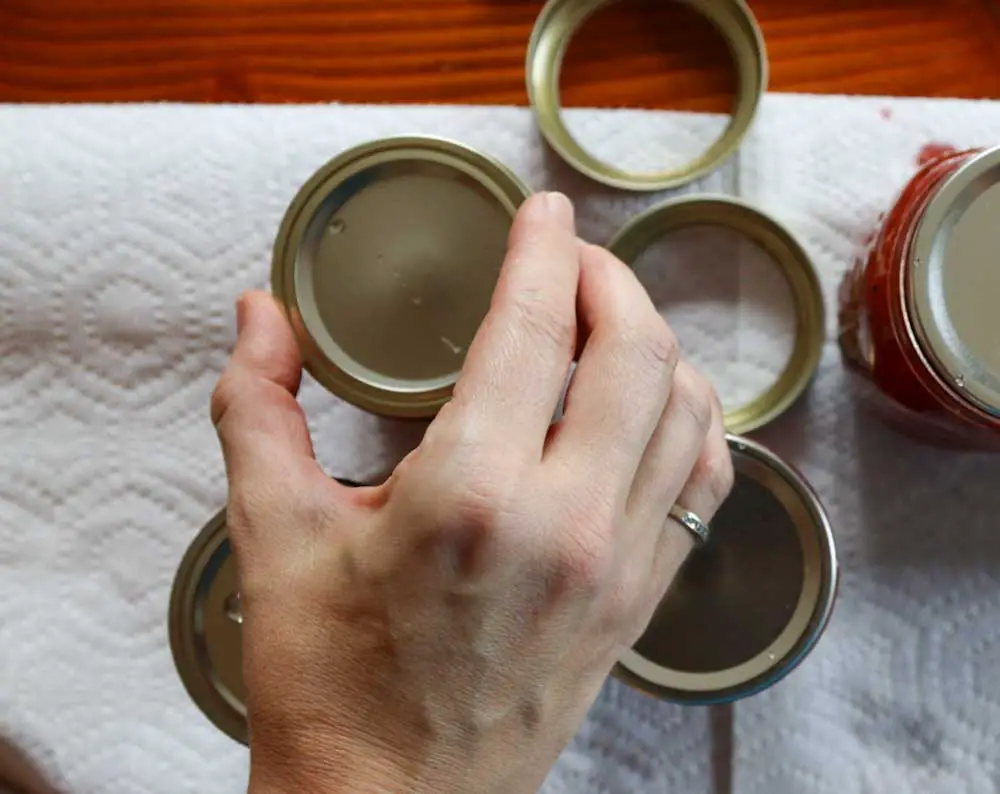
I prefer to process my homemade jam in a water bath for long-term storage. If you are using hot, sterilized jars, process them in boiling water for just 5 minutes. If your jars were clean and hot, but not sterilized, process for 10 minutes. (Longer processing is necessary if you live at high altitude. Here’s a link to my favorite chart for jam processing times.)
My favorite way to eat homemade low-sugar muscadine jam is with fresh bread (preferably sourdough) and butter. Keep it simple. Or use this jam for the most epic peanut butter and jelly sandwich you’ve ever had (concord grape jelly from the store? Never again!).
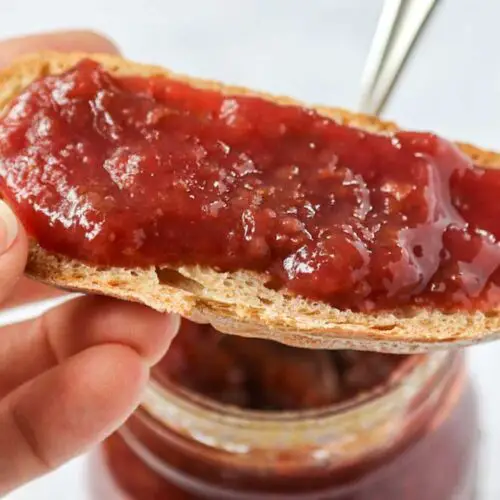
Low-Sugar Muscadine Grape Jam
Equipment
- Saucepan
- Food processor
- Metal strainer/sieve
- Immersion blender or blender (optional)
- Large pot, water bath canner, or pressure canner (optional)
- Jar funnel (optional)
- Jar tongs/lifter (optional)
- Pint or half-pint canning jars, lids, and rings (optional)
Ingredients
- 10 cups of muscadine grapes fresh or frozen
- 2 cups of sugar
- 4 TBSP of low- or no-sugar-needed pectin
- ¼ cup of bottled lemon juice
Instructions
Prepare the Fruit
- Place a couple of spoons in the freezer to chill while making the jam. Thoroughly wash the fresh grapes. If they are frozen, allow them to defrost at room temperature. Remove the skins from each grape: for frozen grapes, simply pinch one end of grape and squeeze out the pulp. For fresh grapes, cut a small X into one end of the grape with a paring knife, then squeeze out the pulp. Separate the pulp and skins.
- Place the grape pulp into a small saucepan over medium heat. Simmer for about 5 minutes, stirring occasionally. Pulse the cooked pulp in a food processor a few times, then strain through a medium-mesh sieve to remove the seeds. Or, put the pulp through a food mill to remove the seeds. Discard the seeds, and put the strained pulp back in the saucepan.
- Put the skins in the food processor and pulse several times until they are finely chopped. Add the chopped skins to the saucepan.
Cook the Jam
- Bring the strained pulp and chopped skins to a simmer over medium heat, then cook for about 10 minutes until the skins have softened. If you want a smooth-textured jam, blend with an immersion blender (or regular blender) to reach the desired consistency.
- Mix the pectin with about ¼ c of the sugar, to help prevent clumping. Add the sugar/pectin mixture and the lemon juice to the simmering fruit, and bring to a full boil. Boil for one minute.
- Add in the rest of the sugar, bring to a boil, and boil for one minute.
- Remove one of the spoons from the freezer and scoop out a little hot jam. Allow it to cool on the spoon for a moment, and check that the jam is jelling. If the jam on the spoon looks thick and viscous, and has little wrinkles of surface tension around the edges, then it is set. If it is still runny, add another tablespoon of pectin to the jam and boil for 1 minute. Test for jell with the other frozen spoon. Taste the jam for sweetness. (If the jam needs to be sweeter, add additional sugar to the jam mixture. Boil the additional sugar in the jam for 1 minute to ensure that it has dissolved.)
- Scoop the jam into jars, and store in the refrigerator for up to 2 weeks. Or, freeze the jam for up to 3 months.
Canning Instructions
- To can the muscadine jam, ladle the hot jam into hot, sterilized jars (you can use clean, hot jars that have not been sterilized, but the processing time will be longer). Wipe the rims of the jars with a damp cloth or paper towel to remove any sticky jam residue. Immediately place a warmed lid on the jar, then twist a lid ring so that it is secure, but not too tight.
- Process the jars in boiling water that sits at least an inch above the tops of the jars. Process sterilized jars at a full, rolling boil for 5 minutes (process for 10 minutes if the jars were hot and clean, not fully sterilized). If you live at an elevation of over 1000 feet, add 1 minute of processing time for each 1000 feet of altitude.
- After the processing time, turn off the heat and allow the jars to sit in the water for 5 minutes so the contents can settle and the boiling can subside. Remove the jars carefully with a jar lifter and place them onto a towel or cooling rack (avoid putting them directly on a cool surface). Allow them to cool at room temperature for 12-24 hours. Put any unsealed jars into the refrigerator to be eaten first. Store unopened, sealed jam in a cool, dark place for 6 months to a year.

